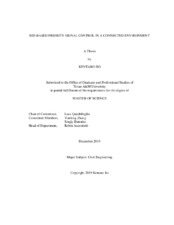| dc.description.abstract | Demand-responsive traffic signal control, like actuated signal control and adaptive traffic signal control, aims to provide efficient movements to road users. Although traffic control signals often treat vehicles as homogeneous objects, in reality road users’ value of time (VOT) may vary depending on their situation. However, little research has been conducted in signal control methods that account for individual differences in VOT. This research introduces the concept of a bid-based priority signal control (BBPSC), a traffic signal control method that considers individual differences in VOT via bids. Within BBPSC, drivers can bid for a green signal indication in a connected environment. In the first phase of research, the author addressed key elements of such a concept. In asymmetric simple exclusion process (ASEP) with two conflicting movements, an algorithm extended a green interval as long as the cumulative opportunity loss observed in stopped movements remained less than the value that would have been lost through the termination of that green interval. BBPSC prioritized high bidders and resulted in a greater subjective user benefit compared to a pre-timed equivalent. In the second phase, the applicability of BBPSC was further investigated with a four-phase signal controller using microsimulations in PTV Vissim.
While BBPSC produced approximately 70 percent longer queues than non-bid-based priority signal control (NBBPSC) in undersaturated conditions, the new control method achieved a smaller delay for high bidders on average, providing user benefit for high bidders. Extremely high bidders experienced a more than 90 percent decrease in delays with BBPSC when measured against NBBPSC. These results proved that typical four-phase traffic control signals can be operated by an algorithm based on bids from road users. Future work should investigate the optimal values of key input variables of BBPSC, especially in highly saturated traffic conditions.
* Part of this section is reprinted with permission from “Bid-Based Priority Signal Control in a Connected Environment: Concept” by Iio, Kentaro, Yunlong Zhang, and Luca Quadrifoglio, 2019. Transportation Research Record: Journal of the Transportation Research Board, https://doi.org/10.1177/0361198119855981, Copyright 2019 Sage Publications, Incorporated. | en |


